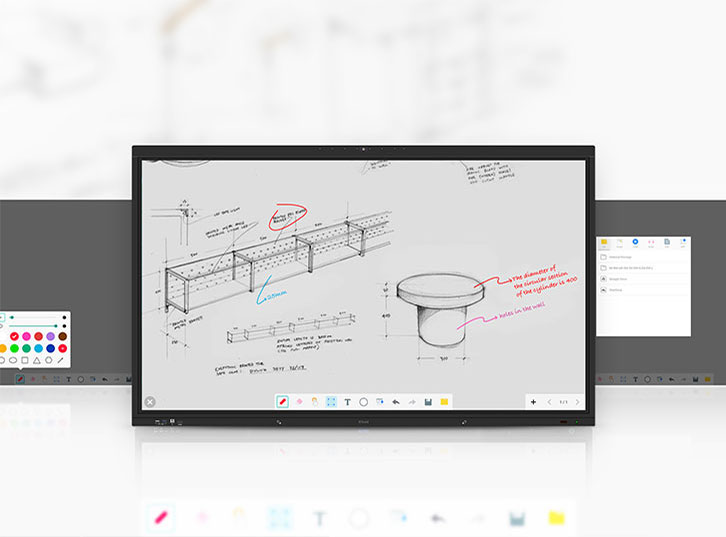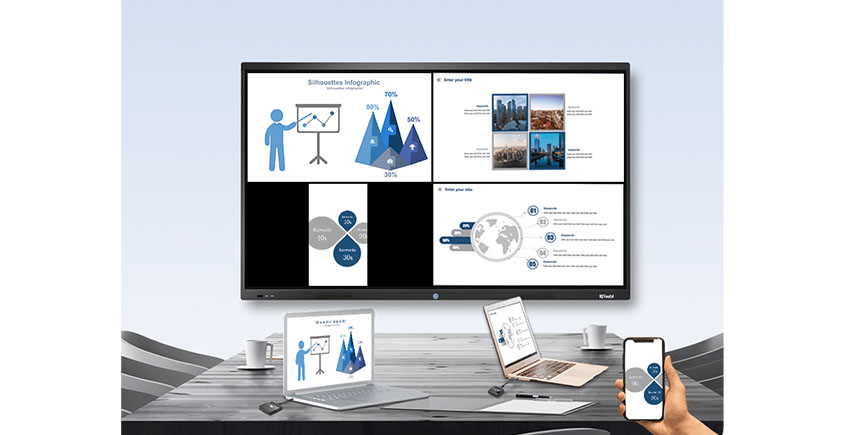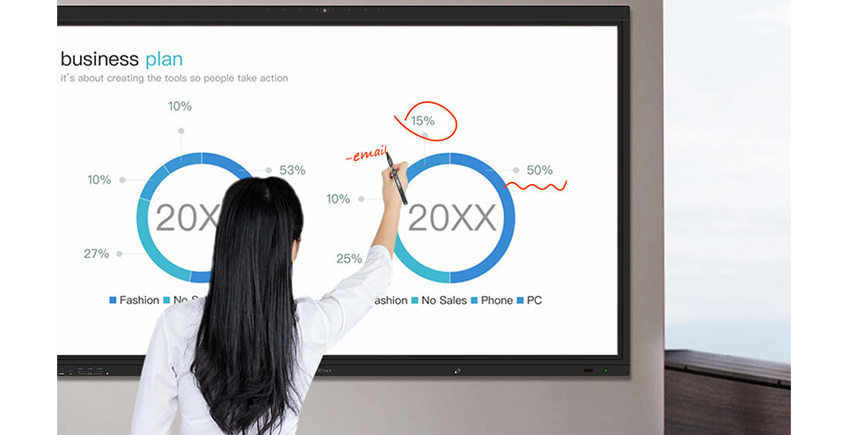In today’s digital world, visual displays play a crucial role in various industries and everyday life. From televisions to interactive displays, these technologies have transformed the way we consume information and interact with our surroundings. In this article, we will explore the technology behind visual displays, how they work, the advancements in display technology, their benefits, and future trends. Additionally, we'll discuss how IQ's innovative products, such as the IQTouch Interactive Flat Panel, is contributing to the evolution of visual display technology and enhancing interactive learning and collaboration.
How Visual Displays Work
Visual displays rely on various technologies to create and showcase images, videos, and other forms of visual content. The two most common display technologies are liquid crystal displays (LCD) and light-emitting diodes (LED).
1.Liquid Crystal Displays (LCD): LCDs utilize a layer of liquid crystal cells placed between two transparent electrodes. These crystals act as shutters, allowing or blocking the passage of light. When an electric current is applied to the liquid crystal cells, they align to control the amount of light passing through, creating the desired image. LCDs are commonly used in devices like televisions, computer monitors, and smartphones.IQ's range of products, such as the IQTouch Interactive Flat Panel, employs LCD technology to provide interactive and collaborative solutions for education and business environments.
2.Light-Emitting Diodes (LED): LED displays consist of an array of tiny light-emitting diodes that produce colored light when an electric current passes through them. Each LED acts as a pixel, and by combining various intensities of red, green, and blue LEDs, a full-color image is formed. LED displays offer energy efficiency, high brightness, and a wide color gamut, making them suitable for large format displays and outdoor applications. IQ's products, like the IQBoard Interactive Whiteboard, also make use of LED technology to enhance interactive learning and collaboration in classrooms and meeting rooms.
Apart from these display technologies, there are other types like organic light-emitting diodes (OLED), which offer better contrast and faster response times, and microLED displays that use tiny LEDs for ultra-high-resolution displays.

Advancements in Visual Display Technology
Over the years, visual display technology has undergone significant advancements, resulting in improved image quality, better power efficiency, and more versatility. Some notable advancements include:
1.High-Resolution Displays: The resolution of displays has significantly improved, with 4K and even 8K resolutions becoming increasingly common. Higher resolutions offer sharper images and more detailed visuals, enhancing the viewing experience. IQ products, such as the IQTouch Interactive Flat Panel, leverage high-resolution displays to provide clear and detailed interactive visuals in educational and business settings.
2.HDR (High Dynamic Range): HDR technology allows for a wider range of colors, contrast, and brightness, resulting in more vibrant and lifelike images. HDR displays provide better representation of both extremely bright and dark areas in visual content.
3.OLED Technology: Organic light-emitting diode (OLED) displays have gained popularity due to their ability to produce deep blacks, rich colors, and wide viewing angles. OLED displays are flexible, enabling curved or even rollable display designs.
4.Touchscreen Technology: Touchscreens have revolutionized the way we interact with displays. Capacitive touchscreens, commonly used in smartphones and tablets, allow for multi-touch gestures and provide a more intuitive and user-friendly experience. IQ products, like the IQTouch Interactive Flat Panel, integrate touchscreen technology for interactive and collaborative learning and presentations.
5.Interactive Displays: Interactive displays take user engagement to the next level by integrating touch functionality with advanced software. These displays find applications in education, businesses, and other sectors where effective collaboration and interactivity are essential. IQ products, including the IQTouch Interactive Flat Panel, exemplify interactive display technology for enhanced learning and collaboration.
6.Virtual and Augmented Reality: Display technology has played a crucial role in the advancement of virtual and augmented reality experiences. VR headsets use high-resolution displays with high refresh rates to provide users with immersive and realistic virtual environments. IQ products contribute to the educational aspect of augmented reality through interactive displays, fostering engaging and interactive learning experiences.

Benefits of Advanced Visual Displays
The advancements in visual display technology bring forth numerous benefits across various industries and applications. Some key advantages include:
1.Enhanced Visual Experience: Advanced displays offer higher resolutions, improved color accuracy, and wider viewing angles, resulting in a more immersive and visually stunning experience. IQ products, such as the IQTouch Interactive Flat Panel, contribute to this enhanced visual experience in education and business settings.
2.Increased Productivity: Interactive displays with touch functionality enable more efficient collaboration and engagement, leading to increased productivity in areas such as business meetings, classrooms, and design studios. IQ's interactive solutions, like the IQTouch Interactive Flat Panel and IQBoard Interactive Whiteboard, are designed to enhance collaboration and productivity.
3.Improved Communication: Visual displays facilitate effective communication by presenting information in a visually appealing and easily understandable format. This is particularly valuable in sectors like digital signage and advertising. IQ's products, including the IQTouch Interactive Flat Panel, offer a platform for effective communication in various applications.
4.Energy Efficiency: Modern display technologies focus on energy efficiency, consuming less power while delivering bright and vibrant visuals. LED displays, for example, are known for their low energy consumption and long lifespan.IQ products, like the IQTouch Interactive Flat Panel, also prioritize energy efficiency.
5.Versatility: Advanced visual displays come in various sizes and form factors, catering to diverse applications. From large-scale video walls to portable tablets, there is a display solution available for every need. IQ's range of products, such as the IQTouch Interactive Flat Panel, offers versatile solutions for education and business environments.

Future Trends in Visual Display Technology
As technology continues to evolve, we can expect further innovations and advancements in visual display technologies. Some of the future trends to watch out for include:
1.Flexible Displays: Flexible display technology will enable new form factors, such as foldable smartphones and rollable televisions. These displays will offer both portability and larger screen sizes when needed.
2.Transparent Displays: Transparent displays have the potential to revolutionize industries like retail and automotive. These displays can be integrated into windows, windshields, and other surfaces to provide information without obstructing the view.
3.Holographic Displays: The development of holographic display technology aims to bring futuristic 3D visuals without the need for special glasses. Holographic displays have the potential to transform fields like gaming, entertainment, and medical imaging.
4.Improved Augmented Reality: Augmented reality displays will become more advanced, allowing for seamless integration of digital content into the real world. This will have a profound impact on industries like gaming, education, and healthcare.
In conclusion, visual display technology has made significant progress in the past few years, leading to enhanced image quality, interactivity, and energy efficiency. As the demand for immersive and engaging visual experiences continues to grow, we can expect further advancements and exciting innovations in the future. From high-resolution displays to futuristic technologies like holographic displays, the visual display landscape holds immense potential to transform numerous industries and elevate the way we perceive and interact with digital content.
For more information on visual displays and their applications, visit our product.php page or contact.php us for further inquiries.
Here are some other articles that we think might interest you:
What is Audio Visual Communication?
The Power of Networked Audio Visual Systems
AV Solution Providers: Your Partner in Audiovisual Excellence